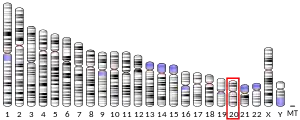DEFB119
Beta-defensin 119 is a protein that in humans is encoded by the DEFB119 gene.[5][6]
| DEFB119 | |||||||||||||||||||||||||||||||||||||||||||||||||||
|---|---|---|---|---|---|---|---|---|---|---|---|---|---|---|---|---|---|---|---|---|---|---|---|---|---|---|---|---|---|---|---|---|---|---|---|---|---|---|---|---|---|---|---|---|---|---|---|---|---|---|---|
| Identifiers | |||||||||||||||||||||||||||||||||||||||||||||||||||
| Aliases | DEFB119, DEFB-19, DEFB-20, DEFB120, ESC42-RELA, ESC42-RELB, DEFB20, defensin beta 119 | ||||||||||||||||||||||||||||||||||||||||||||||||||
| External IDs | OMIM: 615997 MGI: 2385955 HomoloGene: 17045 GeneCards: DEFB119 | ||||||||||||||||||||||||||||||||||||||||||||||||||
| |||||||||||||||||||||||||||||||||||||||||||||||||||
| |||||||||||||||||||||||||||||||||||||||||||||||||||
| |||||||||||||||||||||||||||||||||||||||||||||||||||
| |||||||||||||||||||||||||||||||||||||||||||||||||||
| |||||||||||||||||||||||||||||||||||||||||||||||||||
| Wikidata | |||||||||||||||||||||||||||||||||||||||||||||||||||
| |||||||||||||||||||||||||||||||||||||||||||||||||||
References
- GRCh38: Ensembl release 89: ENSG00000180483 - Ensembl, May 2017
- GRCm38: Ensembl release 89: ENSMUSG00000050645 - Ensembl, May 2017
- "Human PubMed Reference:". National Center for Biotechnology Information, U.S. National Library of Medicine.
- "Mouse PubMed Reference:". National Center for Biotechnology Information, U.S. National Library of Medicine.
- Schutte BC, Mitros JP, Bartlett JA, Walters JD, Jia HP, Welsh MJ, Casavant TL, McCray PB Jr (Feb 2002). "Discovery of five conserved beta -defensin gene clusters using a computational search strategy". Proc Natl Acad Sci U S A. 99 (4): 2129–33. Bibcode:2002PNAS...99.2129S. doi:10.1073/pnas.042692699. PMC 122330. PMID 11854508.
- "Entrez Gene: DEFB119 defensin, beta 119".
Further reading
- Lehrer RI, Ganz T (2002). "Defensins of vertebrate animals". Curr. Opin. Immunol. 14 (1): 96–102. doi:10.1016/S0952-7915(01)00303-X. PMID 11790538.
- Raj PA, Dentino AR (2002). "Current status of defensins and their role in innate and adaptive immunity". FEMS Microbiol. Lett. 206 (1): 9–18. doi:10.1111/j.1574-6968.2002.tb10979.x. PMID 11786250.
- Gerhard DS, Wagner L, Feingold EA, et al. (2004). "The status, quality, and expansion of the NIH full-length cDNA project: the Mammalian Gene Collection (MGC)". Genome Res. 14 (10B): 2121–7. doi:10.1101/gr.2596504. PMC 528928. PMID 15489334.
- Clark HF, Gurney AL, Abaya E, et al. (2003). "The secreted protein discovery initiative (SPDI), a large-scale effort to identify novel human secreted and transmembrane proteins: a bioinformatics assessment". Genome Res. 13 (10): 2265–70. doi:10.1101/gr.1293003. PMC 403697. PMID 12975309.
- Strausberg RL, Feingold EA, Grouse LH, et al. (2003). "Generation and initial analysis of more than 15,000 full-length human and mouse cDNA sequences". Proc. Natl. Acad. Sci. U.S.A. 99 (26): 16899–903. Bibcode:2002PNAS...9916899M. doi:10.1073/pnas.242603899. PMC 139241. PMID 12477932.
- Yamamoto M, Matsui Y (2003). "Testis-specific expression of a novel mouse defensin-like gene, Tdl". Mech. Dev. 116 (1–2): 217–21. doi:10.1016/S0925-4773(02)00144-2. PMID 12128228.
- Deloukas P, Matthews LH, Ashurst J, et al. (2002). "The DNA sequence and comparative analysis of human chromosome 20". Nature. 414 (6866): 865–71. Bibcode:2001Natur.414..865D. doi:10.1038/414865a. PMID 11780052.
This article is issued from Wikipedia. The text is licensed under Creative Commons - Attribution - Sharealike. Additional terms may apply for the media files.



